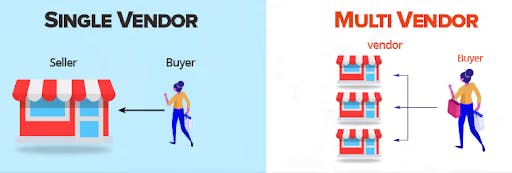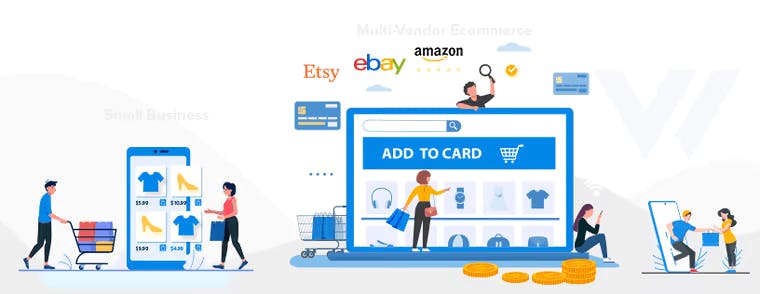The nuances of multi-vendor marketplaces and How is Medusa handling them?
In this article, we will learn about multi-vendor marketplaces and the challenges faced in them, and how Medusa effectively solves these issues.
The link to the original post is here.
Introduction
With the introduction of eCommerce, buying and selling have progressed significantly from the past to speedy online sales. You can now sell door-to-door without any difficulty thanks to eCommerce. Popular eCommerce sites like Amazon, Flipkart, eBay, and others are all up and running, allowing individuals to experience the benefits of hassle-free buying through eCommerce. Multi-vendor marketplaces allow several merchants to sell their products on the same platform nowadays. Let's take a look at what a multi-vendor marketplace is before moving on to the existing eCommerce sites, the challenges faced by them, and suggested multi-vendor platforms.
What is a Multi-Vendor marketplace?

A multi-vendor marketplace is a website that supports several merchants and allows them to sell their products online in a single place. The website's owner is simply responsible for managing the site, while third-party sellers are able to sell their items online. Amazon, eBay, Flipkart, and other popular multi-vendor marketplaces are effectively assisting diverse small to large sellers to sell across several locations.
Multi-Vendor marketplace handles
Manage a huge number of vendors that sell a broad range of items.
When a consumer makes an order with many vendors, you must handle the order from start to finish.
Assuring that orders are ordered, delivered, and paid for in a timely manner.
Providing the seller with their fair portion of the proceeds from the sale made on the website.
Why Multi-Vendor marketplace?
Many businesses now recognize that a basic online store would not be enough and that what they want is an online store that can accommodate hundreds of suppliers and thousands of items. This is when platform builders for multi-vendor marketplaces come in handy!

Benefits of Headless Ecommerce:
Both the seller and the marketplace owner gain profits from a multi-vendor marketplace.
Every transaction results in a profit for the owner, as well as a profit for the seller.
The seller does not need to be concerned with website management
The owner does not need to be concerned about the items and their delivery.
Challenges in a multi-vendor marketplace
When you launch a multi-vendor marketplace, you must attract both buyers and sellers. A merchant may need a greater selling location in order to expand his business, whereas a customer or buyer may desire a variety of choices when purchasing.
Second, you must conduct sufficient research to connect customers and sellers. It is critical to research the market and then get together the appropriate customers and vendors.
Provide an excellent vendor and consumer experience, or they will search for alternatives.
Maintain superior performance in comparison to the competition, or you risk losing both vendors and consumers.
Even if the suppliers handle the orders and merchandise, keep an eye on your store. Otherwise, you may eventually lose control of your business.
Example:
Although Shopify offers a number of benefits that attract businesses and developers, it does so at the cost of less control of the underlying stock. At first, it may appear to be a not so important aspect, especially for small enterprises trying to open a store as quickly as feasible.
Also when extending single systems, developers have challenges in shifting integrations, opening up new markets, and personalizing the user experience.
Because many previous solutions such as WooCommerce lacked geographical flexibility, That is handling different kinds of payments from different shipping providers around the world. This eventually leads to a situation where each market has its own store, which is extremely difficult to maintain.
Platforms like WooCommerce’s solution for dealing with multi-currency issues or integrating with local payment/shipping providers have frequently been developed in separate shops.
Existing headless systems like Magento, need connectors and translation layers between the commerce engine and third-party services. This can be overwhelming at times.
Handling these challenges

You now see why a multi-vendor marketplace is a considerably better alternative for making a profit. So, how do you go about putting one together? There are several eCommerce systems available on the market, including Shopify, Medusa, Magento, and others.
You should identify and select the best platform for hosting your multi-vendor marketplace, as well as a good domain name.
Alternative multi-vendor solution
If you're looking for an open-source platform, Medusa is a headless commerce engine that allows developers to create outstanding powerful eCommerce experiences and construct a simple multi-vendor marketplace with ease.
Medusa is a headless commerce engine, which means it can be used for any type of digital commerce experience. It can be used as the backend for an app, a voice application, social commerce experiences, or a traditional e-commerce website, and you can even integrate Medusa into your own software to enable commerce functionality.
Challenges Medusa help overcome
Talking about Shopify, any company that has grown from a few sales per week to a substantial eCommerce operation understands the value of being able to fully control the technology stack that supports your website. Owning your website's codebase and having the freedom to update and reform it as your business grows is a crucial aspect.
Medusa, on the other hand, has an abstraction-based architecture that allows it to be more extensible and customizable. Medusa is designed for developers, and its architecture, ease of setup, supportive community, and extensive documentation are all geared at giving a positive development experience. Despite being less than a year old, Medusa is already being used in production by merchants all around the world.
Aside from the scalability concerns, utilizing an open-source solution like Medusa ensures that the platform you're using is always free. Because it is frequently directly tied to your income and transaction volume, using Shopify comes with a significant cost that climbs as you scale. This will add to the price of developing and running your system.
Unlike WooCommerce’s geographical flexibility issue, Medusa's adaptability is built-in.
Medusa, on the other hand, ensures that you can change settings and collect orders across nations from a single backend, eliminating the need to run several storefronts at the same time.
Medusa also gives a unique storefront that allows them to control their brand identity and the whole user experience, as well as a versatile backend that allows them to scale as their business grows
Managing gift cards are a useful feature of the admin dashboard. Unlike other tools, such as Magento, which only offer Gift Cards as part of their premium eCommerce option, Medusa allows you to create gift cards and control characteristics such as picture, value, and description.
Medusa's innovative plugin design eliminates the need for complicated infrastructure. In contrast to Magento’s eCommerce platform, which requires connectors and translation layers between the commerce engine and third-party services, in Medusa, the core engine and all plugins operate on the same Node.js server.
Also, Medusa places a great emphasis on improving the developer experience with powerful tooling like quick-starters, documentation, CLI, reference, and so on.
In contrast to WooCommerce, Medusa supports many currencies, and you can add all of them to your store from the dashboard. You should set the default currency and select which additional currencies are allowed in your store.
Closing
You can use Medusa's ability to handle most e-commerce situations, and you can simply add your own features to the dashboard too. However, because all e-commerce tools have their own set of pros and cons, they differ in terms of features and options. I recommend that you examine each one carefully before deciding on the best one.
And would you be interested in building your next eCommerce site with an open-source tool like Medusa? Do let me know in the comment section below. I hope you enjoyed reading it!
Feel free to connect with me on LinkedIn | Twitter
If you like my work, you can extend your support by buying me a ☕. Thank you!


